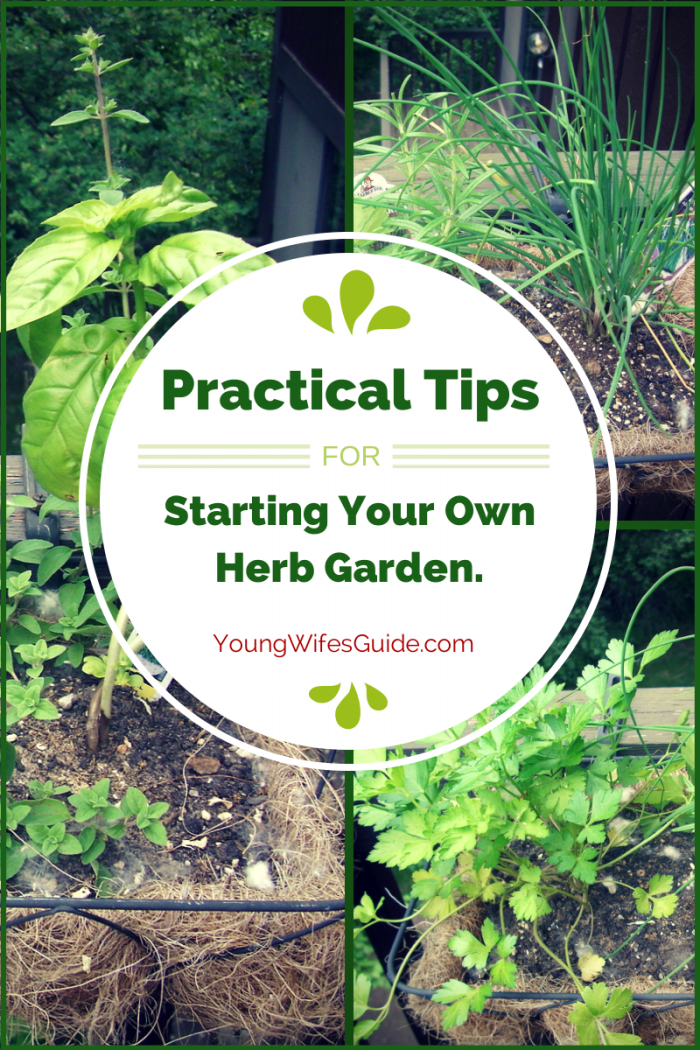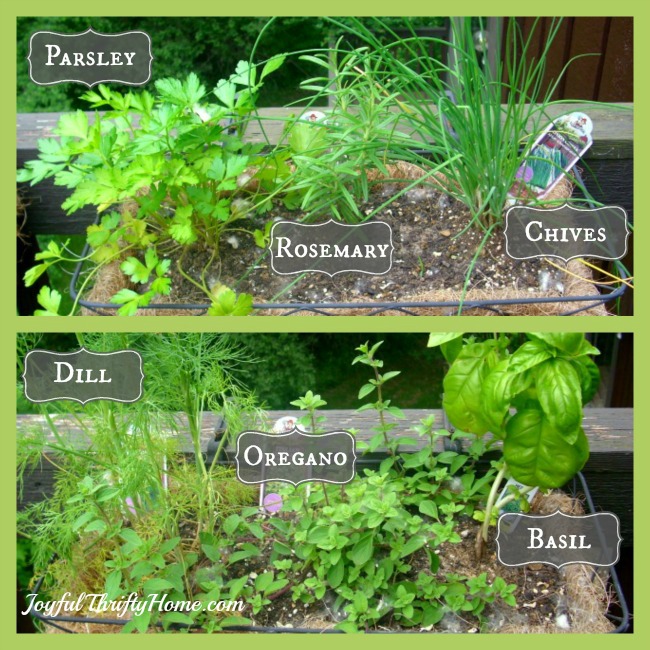Practical Tips for Starting Your Own Herb Garden
By Ashley Roe, Contributing Writer
I long for the day when I can have a full-scale garden packed with my own fresh produce and other plants. I can just picture walking through the garden taking in the sights of all my hard work finally coming up to bloom. There’s even a bench and walkway leading to a little shed which holds all my gardening supplies. I would sit on the bench during sunny afternoons sipping iced tea and reading a book. Sounds like a dream doesn’t it?

There’s a couple of problems with the above scenario. The first is that I currently live in a small second floor condo and have no ground space to work with. The second is that I have limited experience with gardening so my dreams are a tiny bit far-fetched. I would absolutely love to get there someday though. Even though my dream of a large garden is not practical for me now, there are some ways I can enjoy gardening in my small space.
So far, most of my gardening experience comes from helping my mom with a garden when I was younger. We planted some fruits and vegetables as well as flowers for a few years but didn’t get a lot. The ground there is a bit hard so it’s not the best for gardening. We also had small flower gardens for many years which were easier to keep up with. Beyond that, I have kept some flowers on my small balcony and a couple of years ago I started herb gardening. Starting my herb garden is really what spurred my dream of a larger garden someday.
Benefits of Growing Your Own Herbs
If you have limited space like or just want to try out gardening without the huge commitment, then herb gardening might be right up your alley! I love having my own little herb garden because it spruces up my otherwise boring patio and gives me small taste of gardening even though I live in a small condo.
Fresh herbs have also transformed my cooking by giving me a variety of flavors to work with and figure out how to use. There are numerous ways to use your herbs and having a little herb garden is a lot easier than you may think.
1. You don’t need a lot of space
Herbs can be housed in small planter boxes, individual pots outside on your patio or balcony. You can even have a few small pots sitting in a sunny window indoors.
2. It is inexpensive
Buying fresh-cut herbs from the grocery store can add up quickly if you use them often. One young plant will only cost a couple of dollars so it’s much more cost-effective to have your own. Plus they will continue to grow as you use them.
3. It is easy to maintain
All your herb garden needs is access to sunlight, water and some pruning to keep it healthy. Even though I am not a seasoned gardener, I have easily maintained a herb garden during the spring and summer for a few years now.
4. You have easy access to fresh ingredients to add to your cooking
Access to fresh herbs allows you to add lots of great flavors to your food. I love experimenting with my herbs by adding them to a variety of dishes like pasta, chicken, dips, sauces and soups There are so many possibilities!
5. You can preserve the herbs to use all year-long
If you grow your herbs outdoors like I do, you can still preserve them to use in the cooler months of the year. Either bring them indoors and try to maintain them that way or cut them from the stems to dry or freeze for later use. If you are freezing, chop up your herbs and arrange about a tablespoon or so into ice-cube trays. Fill each cube with water or olive oil. When you want to use the herbs, but allow the ice-cube to melt in whatever you are cooking.
Getting Started with Your Herb Garden
Now that you’re convinced to start your own herb garden, let’s look at how to get started.

1. Choose your herbs
When choosing which herbs you want to grow, think about what you will be more likely to use and how much space you have. I only grow six herbs at a time (three per planter). If you have a little more space, you can do more or have multiples of the same kind. Here’s a list of my favorite herbs and what I use them for, plus some other options.
My Favorite Herbs
- Parsley: Great for a variety of soups and sauces or just about anything you want to add a little herb to. I even use it as part of the spread that goes inside my stromboli. it’s also one of many herbs in my favorite grilled chicken marinade.
- Rosemary: Great with chicken. My favorite it herb roasted chicken with rosemary and lemon. Also compliments most Italian dishes. I use it on roasted potatoes too.
- Chives: Is an awesome addition to any potato dish particularly potato soup, mashed potatoes and baked potatoes. It also works well with egg dishes. I use this one more than any of the others! I love the little onion flavor it adds.
- Dill: Makes a tasty addition to spreads or dips. Also works well in seafood dishes. My favorite use for dill is sandwich spread with lemon and garlic. It gives a nice zesty flavor to what would otherwise be a boring sandwich.
- Oregano: Is a wonderful herb for any Italian dish particularly pizza or pasta sauces. Also works well with soups and salads. Oregano is my second favorite herb to chives so I use it a lot!
- Basil: Good for adding on top of pizza or as a compliment with oregano. It’s also the main ingredients in pesto. I also use basil along with oregano when I make tomato soup from scratch.
Other herb choices
- Mint: Use in beverages, as an edible garnish, in salads or dressings. I haven’t had mint in my herb garden yet but I think I will try it this year.
- Cilantro: Goes with many Mexican style dishes like salsa or enchiladas. Often used by sprinkling on top of a dish just before serving. I don’t personally care for the flavor of cilantro so I don’t use it.
- Sage: Wonderful compliment to meats like chicken, turkey, pork or sausage. Sage is the main herb used in my Thanksgiving turkey and cornbread stuffing.
- Thyme: Goes with a lot of dished including meat, soups, vegetables and sauces. It’s a bit of a pain to get off the stem as the leaves are small, but there are a lot of uses for it.
- Tarragon: Works well with poultry, fish and in vinaigrette.
2. Gather your supplies
- Herbs. I recommend starting with plants that are already started instead of seeds. This way, you just have to replant them and you are ready to use your herbs. I get my herbs from a local greenhouse.
- Small pots or planters – the number will depend on how many herbs you choose to have.
- Extra soil for re-planting. A small bag should be plenty.
- A small shovel or something to dig with.
- Plant food (optional). I buy a package of plant food spikes for about $1.50 to help keep my herbs nourished, but this is totally optional.
3. Plan Your Herb Garden
- Decide how you will organize your herb garden. For my herb garden, I have two planters that attach to the railing of my balcony. I’ve seen a lot of other neat ways to grow herbs from arranging individual pots on shelves to attaching them to wood pallets for a vertical garden. Seriously, look up herb gardens on Pinterest or check out my gardening board. You’ll find tons of great ideas. Just don’t blame me if you get lost for hours looking at all the awesome garden ideas.
- Decide where each herb will be placed in your garden. Read the labels if necessary to see which herbs may need a little more sunlight and plan your garden accordingly.
- Place markers for each plant. Again, there are lots of cute ways to do this like painting the name on small rocks or using some other type of marker. You can also just use the tag that comes with the plant to make it simple. The important thing is that you can decipher what each of the herbs are. Some looks similar and you don’t want to think you’re getting parsley and accidentally snip cilantro instead.
4. Get Planting
Now you’ve got it all planned out, the only thing left to do is plant! Just take the herbs from their starter pack and transfer them into your container of choice. Add some more soil around each plant and pack it down. Then mark each plant. Now you are ready to start using your herbs!
What are your favorite plants to grow?
Do you have a dream garden that you hope to grow someday? What do you hope to include?
